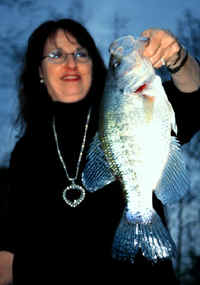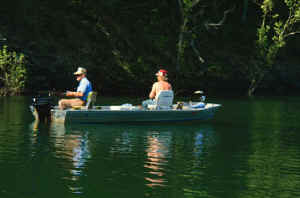February is the Beginning of Crappie Time
February is the Beginning of Crappie Time
By Bill Vanderford
February is sure to bring warmer weather, which will certainly trigger the mating urge in one of Lake Lanier’s favorite fishes....the crappie. These tasty members of the sunfish family are beloved and respected by fisherman of all ages. Probably at some point in most anglers’ lives, they have enjoyed catching crappie in good numbers, when other game fish were not available, or maybe they just had the pleasure of sitting down to a mouth-watering meal of fried crappie.
 Here at Lake Lanier, the availability of crappies in great numbers, a readiness to feed, and excellent table quality are the reasons for its popularity. In fact, the crappie is probably one of the easiest fish to understand and catch. Nevertheless, additional knowledge of the crappie’s movements and habits will assure an angler full stringers of these tasty members of the sunfish family.
Here at Lake Lanier, the availability of crappies in great numbers, a readiness to feed, and excellent table quality are the reasons for its popularity. In fact, the crappie is probably one of the easiest fish to understand and catch. Nevertheless, additional knowledge of the crappie’s movements and habits will assure an angler full stringers of these tasty members of the sunfish family.
Major movement of crappies up into the rivers or feeder creeks begins when the water temperature rises above 55 degrees. During most of the spring, crappies will congregate in underwater brush, blown-down trees, aquatic plant growths, or irregular rock formations along channel breaks near the mouths of feeder creeks or long coves off of the main river channels. The best coves or creeks are those that contain plenty of brush or trees and have running water or perceptible current flow.
Crappie schools can often be located by drifting, trolling, or casting with tiny jigs or minnows. When a school is located by any of these methods, mark the spot with a buoy, then pick up a light to ultra-light spinning or spincast rod and reel. Since crappies prefer slow-moving baits and a fast fall sometimes spooks them, lower a jig or minnow slowly. If the crappies or the structure being fished can be seen on a sonar unit, put the bait right into the middle of the school or top of the structure and let it sit motionless. If a bite isn't felt in 15 seconds, move the offering horizontally with an extremely slow, steady sweep of the rod. Once the sweep is started, don't stop or the jig will lose its appeal. At the end of the sweep, begin raising the rod and increase the speed slightly to make it look like a baitfish sneaking away. If the cover is thick, eliminate the horizontal movement and just move the jig slowly up and down.
These suspended crappies can also be caught by jigging for them with smaller jigging spoons like the I/2 or 1/3 ounce Luhr-Jensen Crippled Herring. Jig these tiny shad-like spoons straight up and down with a slow, deliberate action.
 Another tactic is to vertically fish from a boat with a medium-light graphite spinning rod of 6 or more feet. Rig it with 4-pound line and a small minnow or shad hooked to a jig or plain hook. Lower the bait to the appropriate depth as indicated by the sonar unit. Hold the line or rod in ungloved fingertips, so that the crappie’s light tap can be felt. If the strikes are too soft to detect easily, watch the rod-tip and line, or use a sensitive slip float. When using multiple baits, some anglers have great success with a pair of minnows fished 18 inches apart.
Another tactic is to vertically fish from a boat with a medium-light graphite spinning rod of 6 or more feet. Rig it with 4-pound line and a small minnow or shad hooked to a jig or plain hook. Lower the bait to the appropriate depth as indicated by the sonar unit. Hold the line or rod in ungloved fingertips, so that the crappie’s light tap can be felt. If the strikes are too soft to detect easily, watch the rod-tip and line, or use a sensitive slip float. When using multiple baits, some anglers have great success with a pair of minnows fished 18 inches apart.
As the water warms into the lower 60's, the larger crappie schools start to break up into smaller groups. These tiny concentrations then seek out shallower structure in which to spawn. Tactics have to change, but several very productive methods for both locating and catching these spawning crappies exist.
Ease along the shoreline casting a small jig until one crappie is caught. Then put on a minnow rig and keep casting into that school until they quit hitting. Continue moving down the bank and look for another concentration of crappies.
When visible cover is seen along the shoreline, combine the smaller jigs with a weighted bobber to be even more efficient. Cast this rig past the structure, then retrieve the lure steadily, but sluggishly, past the cover. It is important to keep the jig in the strike zone as long as possible.
Other than the visible and unseen underwater structures, boat docks are a great place for holding crappies. Plenty of these man-made structures can be found, and many have fish attracting brush piles nearby.
Night fishing can also be very productive, especially during April and May. The areas around bridges can be excellent during this post spawn period, or out in the middle of any creek channel utilizing lanterns or other artificial lights with live minnows dangled at 12 to 25 feet.
Using any of these methods at the proper time and place will greatly increase your odds of catchin’ plenty of big “slab” crappies this spring. However, never forget that suggestions of time and place are generalities at best. Like my Dad always said, “The best time to fish is when you can, and the best place is where you are!”
|
